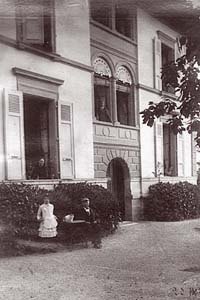|
 The Clarens Connection
The Clarens Connection
by JENNIFER PAULL
Just two weeks before Tchaikovsky's death from cholera, young Stravinsky and the elder composer met backstage at the Imperial Opera in St Petersburg where Stravinsky's father had just sung in Glinka's Ruslan and Ludmilla.
Both composers found the small lakeside village of Clarens outside Montreux (now swallowed as its western suburb), to be a haven of inspiration. Catherine Stravinsky's poor health had been the underlying reason for the migration in the summer of 1910. They finally settled comfortably into the Villa Pervenche, Ernest Ansermet's former home. Amongst other works, Bajka, L'Histoire du Soldat, Petrouchka, The Song of The Nightingale, Svadebka and part of The Rite of Spring were composed there. Ill health and tuberculosis dogged his family. However, the beauty of long, lakeside walks nurtured Stravinsky's creativity as Tchaikovsky's before him.
In 1917, Stravinsky met Picasso in Italy. The artist sketched his new friend and the composer packed the precious gift into his suitcase to bring it back to his Swiss home. When a diligent customs officer dug it out, he presumed that Stravinsky was a spy and this was his plan of action. Stravinsky recalled:
|
'What is this sketch?'
'My portrait drawn by Picasso.'
'Nonsense. It must be a plan.'
'Yes -- the plan of my face.'
|
The 'spy' was obliged to ask his friends at the British Embassy for clearing identification. Little has changed in Switzerland. 'Terrorist' Pierre Boulez was not above having a spot of bother in 2001. At the age of 75, Police dragged him from his hotel bed in a pre-dawn raid in Bâle. He was detained and his passport confiscated. During the 1960s, he had once innocently remarked that 'opera houses should be blown up'. Swiss officials appear to remain faithful to their same, culturally-intense training courses.

Pension Richlieu in 1885
After a misguided marriage of remarkable brevity to one of his lady admirers, Tchaikovsky jettisoned himself out of Russia in 1877 to land in Switzerland and move into the Pension Richelieu in Clarens complete with lock, piano, stock and Yosif Yosifovitch Kotek. The Dutch king William III, under the name of 'Count von Buren' had greatly amused his entourage with his eccentric behaviour in the same villa just two years before Tchaikovsky's own marital-breakdown therapy.
Young Kotek (22) was one of Tchaikovsky's pupils and a witness at his catastrophic wedding. In their Swiss retreat, Tchaikovsky composed Eugene Onegin, Joan of Arc and the Violin Concerto. One way or another, he overcame his marriage blues.
The Casino-Kursaal de Montreux had officially opened in 1881 for the entertainment of guests staying at sumptuous villas, hotels and palatial residences in and around town. It became the home of the famous Kursaal Orchestra directed by Ernest Ansermet, which was to host Stravinsky's first conducting engagement outside Russia. The attitude that 'classical' music is for the élite sadly still permeates contemporary Switzerland well over a century later.
The Casino was sold to the Tourist Office in 1943 and the orchestra has totally evaporated from even visible, civic memory. On 4 December 1971, the building burnt down after a Frank Zappa and the Mothers of Invention concert. A member of Deep Purple was in Montreux at the time. Inspired by the flames, thick smoke and their proximity to the lake, he penned the international hit Smoke on the Water, doubtless reaching an instant and larger public with this composition than his esteemed forefathers with many of theirs.
Although there is the Stravinsky Auditorium, home (with the Casino and the lakeside walkways) of the Montreux Jazz Festival and a street in Clarens (Rue Sacre du Printemps), the local, general public today know little about Stravinsky or Tchaikovsky. As for the latter, after having lived in this region for two decades, I know of no memorial to his fruitful stay. Tchaikovsky's passing through would appear to have been far more discreet than his personal passions, which sadly, may have had something to do with it.
The statue of Farrokh Bulsara dominates the lakeside where both Tchaikovsky and Stravinsky once sought and found much delight. Better known as Freddie Mercury, he adored Montreux and bought a home in Territet (now ingested as its eastern suburb). Queen recorded in the Montreux studios and the Municipality has honoured Mercury, as they have forgotten Tchaikovsky and the great Kursaal Orchestra in terms of the visible epitaph. That which previous generations of officialdom may once have rejected, appears finally and fortuitously to be ignored today.
He who is commercially and more touristically viable gets the statue. This is the litmus test of much municipal, artistic valuation.
Graduates from Culturally-Intense Courses in Mind-Enrichment for Bureaucratic Officialdom proliferate globally and often betray Olympic ignorance. The Artistically Aware minority decreases in inverse proportion to the King Kong Pop Culture invasion somewhat faster than the icecaps melt. The only thing new about that is global warming.
Decade by decade ... popular culture, with its stunning commercial success, has gained strength until it now no longer is the brash alternative ... it IS the culture ...
- Camille Paglia (born 1947),
Arion (A Journal of Humanities and the Classics), The Magic of Images: Word and Picture in a Media Age (expanded text of her lecture given at York University, Toronto -- 15 November 2002)
Copyright © 1 August 2005
Jennifer I Paull, Vouvry, Switzerland

| 
